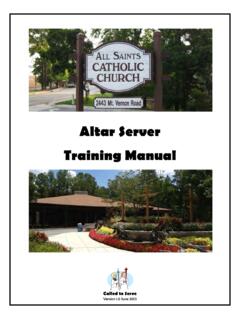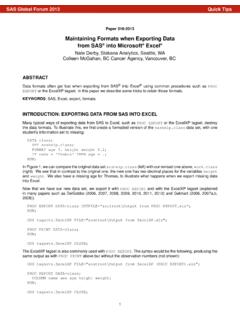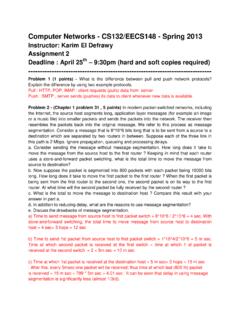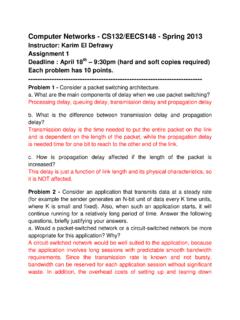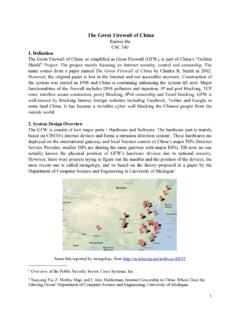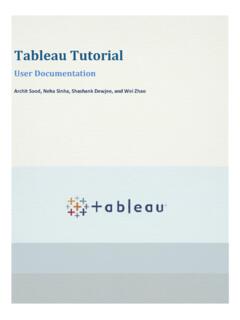Transcription of Best Practices Guide for Energy-Efficient Data Center Design
1 FEDERAL ENERGY MANAGEMENT PROGRAMBest Practices Guide for Energy-Efficient Data Center DesignRevised March 2011 Prepared by the National Renewable Energy Laboratory (NREL), a national laboratory of the Department of Energy, Office of Energy Efficiency and Renewable Energy; NREL is operated by the Alliance for Sustainable Energy, LLC. FEDERAL ENERGY MANAGEMENT PROGRAMA cknowledgements | ContactsAcknowledgementsThis report was prepared by John Bruschi, Peter Rumsey, Robin Anliker, Larry Chu, and Stuart Gregson of Rumsey Engineers under contract to the National Renewable Energy Laboratory. The work was supported by the Federal Energy Management Program led by Will Lintner Bill Tschudi Otto VanGeet Department of Energy FEMP Lawrence Berkeley National Laboratory National Renewable Energy Laboratory 202-586-3120 510-495-2417 303-384-7369 Errata SheetNREL REPORT/PROJECT NUMBER: NREL/BR-7A40-47201 DOE NUMBER: DOE/GO-102010-2956 TITLE: FEMP Best Practices Guide for Energy-Efficient Data Center DesignAUTHOR(S): Otto VanGeetORIGINAL PUBLICATION DATE: February 2010 DATE OF CORRECTIONS: March 4, 2011 The following corrections were made to this report/document:Revised March 2011: Page 4, Figure 2: the green line in the chart has a missing vertical side on the left Action: Need to connect the line (as annotated in accompanying PDF).
2 Page 16 -17: Need to add Note after last paragraph on page 16: The Green Grid has proposed and defined a metric for Measuring the Benefit of Reuse Energy from a Data Center ; the Energy Reuse Effectiveness, or ERE. For more information see Pages 18: Need to add new section after first paragraph on pg 18: (Bold heading) Energy Reuse Effectiveness (ERE) (body) ERE is defined as the ratio of the total energy to run the data Center facility minus the reuse energy to the total energy drawn by all IT equipment: ERE = Cooling+Power+Lighting+IT-Reuse IT IT Equipment Energy IT Further examination of the properties of PUE and ERE brings out another important result. The range of val ues for PUE is mathematically bounded from to infinity. A PUE of means 100% of the power brought to the data Center goes to IT equipment and none to cooling, lighting, or other non-IT loads. For ERE, the range is 0 to infinity. ERE does allow values less than An ERE of 0 means that 100% of the energy brought into the data Center is reused elsewhere, outside of the data Center control volume.
3 For more information see for Hard Copies: No revised copies will be the CoverCenter for Disease Control and Prevention's Arlen Specter Headquarters and Operations Center reached LEED Silver rating through sustainable Design and operations that decrease energy consumption by 20% and water consumption by 36% beyond standard codes. PIX of the Alliance for Sustainable Energy, LLC, under Contract No. DE-AC36-08GO28308 with the Dept. of Energy have authored this work. The United States Government retains and the publisher, by accepting the article for publication, acknowledges that the United States Government retains a non-exclusive, paid-up, irrevocable, worldwide license to publish or reproduce the published form of this work, or allow others to do so, for United States Government purposes. FEDERAL ENERGY MANAGEMENT PROGRAM iTable of ContentsTable of ContentsTable of ContentsSummary .. 1 Background.. 1 Information Technology (IT) Systems.
4 1 Efficient Servers .. 1 Storage Devices.. 2 Network Equipment.. 2 Power Supplies .. 2 Consolidation.. 3 Hardware Location .. 3 Virtualization .. 3 Environmental Conditions..42009 ASHRAE Guidelines and IT-Reliability.. 4 Air Management ..5 Implement Cable Management .. 5 Aisle Separation and Containment.. 5 Optimize Supply and Return Air Configuration.. 7 Raising Temperature Set Points.. 8 Cooling Systems ..8 Direct Expansion (DX) Systems.. 8 Air Handlers.. 9 Central vs. Modular Systems .. 9 Low Pressure Drop Air Delivery.. 10 High-Efficiency Chilled Water Systems .. 10 Efficient Equipment .. 10 Optimize Plant Design and Operation .. 10 Efficient Pumping .. 11 Free Cooling.. 11 Air-Side Economizer .. 11 Water-Side Economizer .. 12 Thermal Storage .. 12 Direct Liquid Cooling .. 12 Humidification.. 12 Controls.. 12ii FEDERAL ENERGY MANAGEMENT PROGRAMT able of ContentsElectrical Systems..13 Power Distribution .. 13 Uninterruptible Power Supplies (UPS).
5 13 Power Distribution Units (PDU) .. 14 Distribution Voltage Options .. 15 Demand Response.. 15DC Power .. 15 Lighting.. 16 Other Opportunities for Energy-Efficient Design ..16On-Site Generation.. 16Co-generation Plants.. 16 Reduce Standby Losses .. 16 Use of Waste Heat.. 16 Data Center Metrics and Benchmarking ..17 Power Usage Effectiveness (PUE) and Data Center Infrastructure Efficiency (DCiE) .. 17 Energy Reuse Effectiveness (ERE) .. 18 Rack Cooling Index (RCI) and Return Temperature Index (RTI) .. 18 Heating, Ventilation and Air-Conditioning (HVAC) System Effectiveness.. 19 Airflow Efficiency.. 19 Cooling System Efficiency.. 20On-Site Monitoring and Continuous Performance Measurement .. 20 Bibliography and Resources ..21 FiguresFigure 1: Efficiencies at varying load levels for typical power 2: 2009 ASHRAE environmental envelope for IT equipment air intake 3: Example of a hot aisle/cold aisle 4: Sealed hot aisle/cold aisle 5: Comparison of distributed air delivery to central air 6: Typical UPS efficiency curve for 100 kVA capacity and greater.
6 14 TableTable 1: ASHRAE Recommended and Allowable Inlet Air for Class 1 and 2 Data Centers FEDERAL ENERGY MANAGEMENT PROGRAM 1 Summary | Background | Information Technologies (IT) SystemsSummaryThis Guide provides an overview of best Practices for Energy-Efficient data Center Design which spans the categories of Information Technology (IT) systems and their environmental conditions, data Center air manage-ment, cooling and electrical systems, on-site generation, and heat recovery. IT system energy efficiency and environmental conditions are presented first because measures taken in these areas have a cascading effect of secondary energy savings for the mechanical and electrical systems. This Guide concludes with a section on metrics and benchmarking values by which a data Center and its systems energy efficiency can be evaluated. No Design Guide can offer the most Energy-Efficient data Center Design but the guidelines that follow offer sugges-tions that provide efficiency benefits for a wide variety of data Center Center spaces can consume up to 100 to 200 times as much electricity as standard office spaces.
7 With such large power consumption, they are prime targets for Energy-Efficient Design measures that can save money and reduce electricity use. However, the critical nature of data Center loads elevates many Design criteria chiefly reliability and high power density capacity far above energy efficiency. Short Design cycles often leave little time to fully assess efficient Design opportunities or consider first cost versus life-cycle-cost issues. This can lead to designs that are simply scaled up versions of standard office space approaches or that reuse strategies and specifications that worked good enough in the past without regard for energy performance. This Best Practices Guide has been created to provide viable alternatives to inefficient data Center building Technology (IT) SystemsIn a typical data Center with a highly efficient cooling system, IT equipment loads can account for over half of the entire facility s energy use.
8 Use of efficient IT equipment will significantly reduce these loads within the data Center , which consequently will downsize the equipment needed to cool them. Purchasing servers equipped with Energy-Efficient processors, fans, and power supplies, high-efficient network equipment, consolidating storage devices, consolidating power supplies, and implementing virtualization are the most advantageous ways to reduce IT equipment loads within a data ServersRack servers tend to be the main perpetrators of wasting energy and represent the largest portion of the IT energy load in a typical data Center . Servers take up most of the space and drive the entire operation. The majority of servers run at or below 20% utilization most of the time, yet still draw full power during the process. Recently vast improvements in the internal cooling systems and processor devices of servers have been made to minimize this wasted purchasing new servers it is recommended to look for products that include variable speed fans as opposed to a standard constant speed fan for the internal cooling component.
9 With variable speed fans it is possible to deliver sufficient cooling while running slower, thus consuming less energy. The Energy Star program aids consumers by recognizing high-efficiency servers. Servers that meet Energy Star efficiency requirements will, on average, be 30% more efficient than standard , a throttle-down drive is a device that reduces energy consumption on idle processors, so that when a server is running at its typical 20% utilization it is not drawing full power. This is also sometimes referred to as power management. Many IT departments fear that throttling down servers or putting idle servers to sleep will negatively impact server reliability; however, hardware itself is designed to handle tens of thousands of on-off cycles. server power draw can also be modulated by installing power cycler software in servers. During low demand, the software can direct individual devices on the rack to power down. Potential power management risks include slower performance and possibly system failure; which should be weighed against the potential energy FEDERAL ENERGY MANAGEMENT PROGRAMS ummary | Background | Information Technologies (IT) SystemsInformation Technologies (IT) SystemsMulti-core processor chips allow simultaneous processing of multiple tasks, which leads to higher efficiency in two ways.
10 First, they offer improved performance within the same power and cooling load as compared to single-core processors. Second, they consolidate shared devices over a single processor core. Not all applica-tions are capable of taking advantage of multi-core processors. Graphics-intensive programs and high perfor-mance computing still require the higher clock-speed single-core energy savings can be achieved by consolidating IT system redundancies. Consider one power supply per server rack instead of providing power supplies for each server . For a given redundancy level, integrated rack mounted power supplies will operate at a higher load factor (potentially 70%) compared to individual server power supplies (20% to 25%). This increase in power supply load factor vastly improves the power supply efficiency (see Figure 1) in following section on power supplies). Sharing other IT resources such as Central Processing Units (CPU), disk drives, and memory optimizes electrical usage as well.










